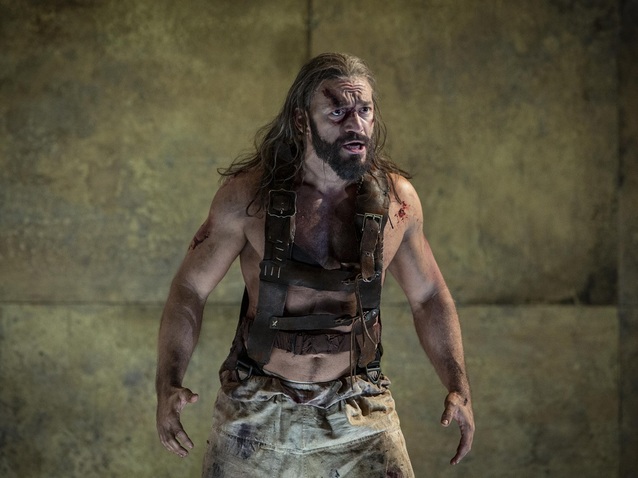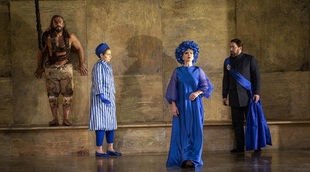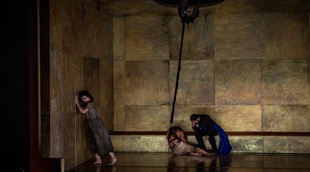 © (c) Kip Carroll
© (c) Kip Carroll
Although better known today for his concertos, in his own lifetime Antonio Vivaldi was just as famous for his operas. He claimed to have written ninety-four, and while it is impossible to prove he ever composed quite so many, we do know of at least thirty-two. Bajazet of 1735 is one of these although strictly it is a pasticcio, which is a work built around music (usually from a range of composers) that by and large already exists. In this instance, it seems that Vivaldi himself composed the arias for the good characters, in some cases recycling material he had written for other operas, and used other composers’ music for the villains. The story tells of the fate of the Ottoman Sultan Bayezid I after he is captured by Tamerlano, the Turco-Mongol conqueror Timur Lenk who founded the Timurid Empire, following defeat at the Battle of Ankara in 1402.

Gianluca Margheri (Bajazet), Aoife Miskelly (Idaspe), Claire Booth (Irene) and Eric Jurenas (Andronico) (c) Kip Carroll
While, however, the figures and background are historical, the story as it is told is more reflective of the age in which the opera was written. The original audiences would not have sat silently throughout as a default as we do today, and so the onus was on the composer and librettist (Agostino Piovene in this instance) ensuring that the opera made them want to keep watching. The way to do this was to pack in as much drama as possible so that every scene or aria presented a challenge, problem or dilemma. The theory was that the more twists, turns and moments of revelation there were, the more likely an audience was to stay gripped.
As a result, while the story tells of the dilemma faced by Andronico, a Prince of Greece, who loves Bajazet’s daughter Asteria but is offered the Byzantine Empire by Bajazet’s enemy Tamerlano, and of the antagonism between Tamerlano, Andronico, Asteria and Irene (Princess of Tresbisond) over who of them will marry who, the overall narrative arc is arguably less important than the multitudinous scenes of conflict that are generated along the way. If, however, the plot might feel as if it is unwieldy almost for the sake of being so, this does create a multi-layered affair in its own right. Characters are not presented with simple choices between one of two things, but rather must make their decisions while remaining uncertain of what others are thinking, feeling or planning to do.
In Adele Thomas’s production for Irish National Opera, the sense of drama is certainly allowed to come to the fore as the ostensibly simple staging actually possesses many hidden depths. It is performed in the Royal Opera House’s intimate Linbury Theatre, which is ideally suited to giving the action an immediacy of purpose. Molly O’Cathain’s box-like set instantly gives the impression of a claustrophobic space that can overheat with emotion, and from which there is little hope of escape. This is especially since, while a single set is used throughout to represent a variety of places, its cold stone walls very much make it the prison in which Bajazet is held. In fact, he is roped to a large hook that hangs from a hole in the ceiling, with this set-up proving key to how certain events unfold. Bajazet lashes out at Andronico in Act I and tries to kill Tamerlano in Act III, but the rope prevents him from inflicting any damage in both instances by restricting how far he can move. The hole and hook also provide some visual variation to what would otherwise be a totally symmetrical, and far less interesting, set.

Gianluca Margheri (Bajazet), Eric Jurenas (Andronico), Niamh O’Sullivan (Asteria) and Aoife Miskelly (Idaspe) (c) Kip Carroll
Many arias are accompanied by visual actions that play out the subtexts, so that as Andronico sings ‘La sorte mia spietata’ in Act II, Tamerlano tries to conquer Asteria and she successfully fights back. However, it does not feel as if a different ‘hook’ is being applied to each aria simply for the sake of it because the movements complement the music so well. They can even accentuate the differences between the arias so that the alteration in tone between Tamerlano’s ‘cruda sorte, avverrso fato!’ and Asteria’s ‘La cervetta timidetta’ that follows it in Act II feels especially marked. In addition, the visuals that are applied to each aria do not stand in isolation but remain in keeping with the wider points that the production makes. In this way, Tamerlano is shown not to be a brave warrior but rather a disturbed tyrant who can collapse distraught in Irene’s lap, and requires medication (Andronico’s friend Idaspe repeatedly tries to sedate him or more) in order to be kept under control. The costumes the characters wear cover a variety of eras, while Idaspe addresses the audience during part of the opening Sinfonia, thus explaining the background to the story and making it easier to understand.
The playing of the Irish Baroque Orchestra, conducted from the harpsichord by Peter Whelan, is extremely fine while everyone in the cast leaves a strong impression. With his exceptionally powerful bass-baritone, Gianluca Margheri gives a commanding performance in the title role while the countertenors of Eric Jurenas as Andronico and James Laing as Tamerlano work very well for their respective characters as Jurenas’s sound is clear and bright while Laing’s feels fuller and more nuanced. Niamh O’Sullivan offers a beautifully rich, and sometimes quite dark, mezzo-soprano as Asteria while Claire Booth as Irene excels in the famous aria ‘Sposa son disprezzata’, and Aoife Miskelly offers both excellent singing and astute acting in the trouser role of Idaspe.
By Sam Smith
Bajazet | 4 - 12 February 2022 | Linbury Theatre, Royal Opera House, Covent Garden
the 09 of February, 2022 | Print

Comments